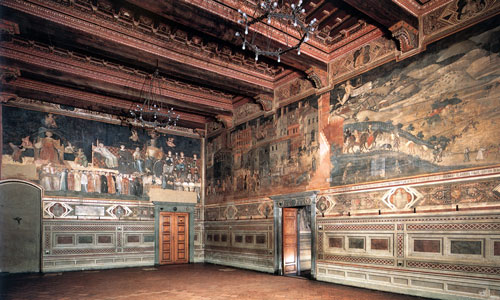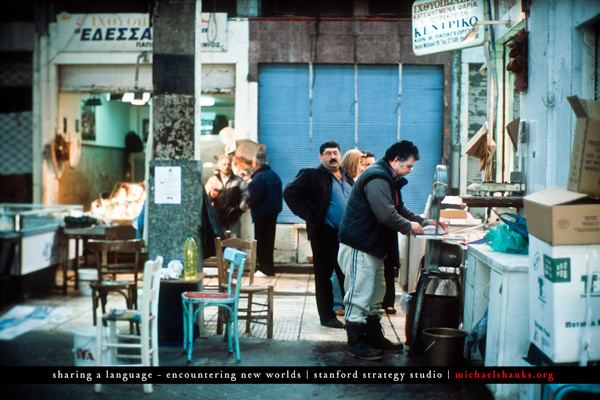great conversations that make a difference
co Founder - Douglass Carmichael, Stanford Media X
2008 - 2011

Good and bad government: the Lorenzetti murals in the Palazzo Pubblico, Siena
How did we get to where we are now?
What is really at stake?
How do we make informed decisions about
where we want to be in the future?
... decisions informed by deep and broad understanding of long-term trends as well as local sensitivity
... decisions informed by human sensitivity.
Stanford Strategy Studio was a project to build an architecture for the conversations at the heart of such forward thinking ...
great conversations about difficult and important issues, in a collegial environment rich in artifacts and knowledge drawn from the Humanities and Arts, enhanced by a long term historical perspective
open conversations across diverse fields, generating an intellectual “buzz” that enables thinking outside the box.
Stanford Strategy Studio was a project to develop environments designed to enhance discussion, strategic planning and collaborative decision making around matters of common and pressing human concern.
The conversations and experiments ran from the summer of 2008 till summer 2011.
We started from the experience that strategic conversations in major organizations tend to be narrow in focus and unhistorical in framing. Our initiative had two key aspects:
- to bring together in conversations those whose professional focus is on key issues and those whose humanistic study might provide valuable knowledge - from history, philosophy, literature, archaeology ...
- to provide a rich surround of supporting images and artifacts - architectures, real and virtual, that provide participatory access to an archive of discussions set in context of themes, trends and narratives drawn particularly from the Humanities and Arts.
We developed principles and practices for open, extended and iterative conversation that inform more effective action in and around matters such as environmental change, energy, new media and technologies, the global market, sustainable planning and design, local democratic agency.
Our proposition is that the Arts and Humanities can provide fresh insight into matters of common concern when they are brought together with project-focused experts.
For example, a review of Stanford Humanities faculty statements of interest on departmental websites indicates that over one half express an interest in issues that pertain directly to public policy. This is as true in philosophy as in history and economics. The writings by many Humanities faculty show a deep understanding of issues that are in public debate, but for the most part these faculty are not connected to policy discussions. Policy suffers as a result.
We aimed to use the Humanities and Arts to refresh and jump the level of public discussion to new kinds of significance, to help meet the complexities for governance and sound social and strategic thinking in these deeply challenged times.
We used of a range of analog and digital tools to develop rooms with memory. These architectures need to be composites of real and virtual: we have experience of the tremendous potential of online 3D worlds for facilitating internationally distributed encounter and discussion, and have strategy rooms in online Second Life as well as experimenting with Stanford's own digital world currently in development in our computer science department. Visualization is a key component. We used large printouts of time lines and concept maps, charts, high resolution and interactive displays enabling navigation through such diagrams and environments — deep visual maps of both past conversations and also broad analytic context for addressing questions such as How did we get here? Where are we now? What are the scenarios going forward? Open participation is a key component. As well as online 3D environments, we used participatory and social software to share the conversations, opening them up to the civic world of the digital commons.
Our new strategy model was based on
- these rich environments
- historical and humanistic context
- iterative definition of issues and concerns
- greater focus on the motives and perspectives of each participant
- a broader outreach for potentially relevant frames of reference and contribution
- a greater appreciation for the fit between motives and values of participants and the proposed courses of action.
Stanford Strategy Studio - images

